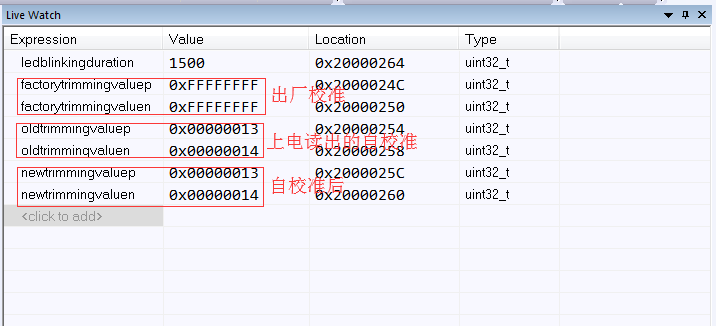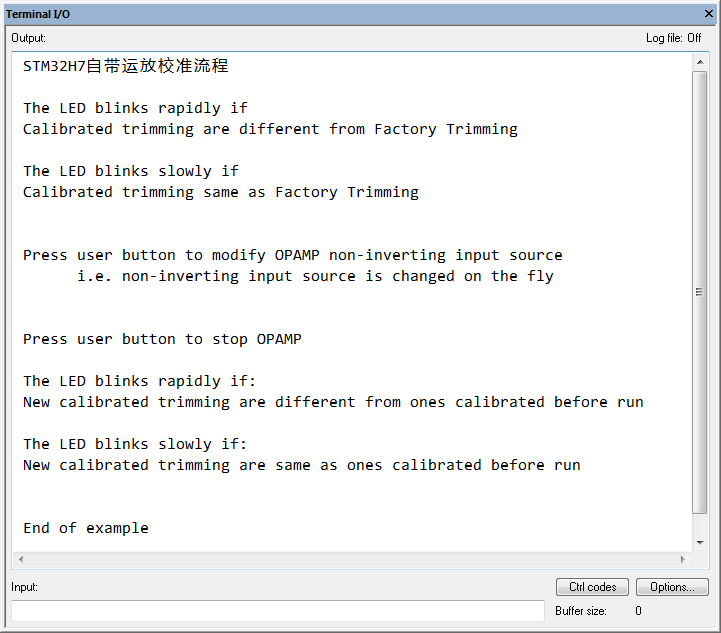|
|

楼主 |
发表于 2018-9-15 02:20:44
|
显示全部楼层
代码也贴一下,方便以后直接查阅:

- /* Private typedef -----------------------------------------------------------*/
- /* Private define ------------------------------------------------------------*/
- /* Private macro -------------------------------------------------------------*/
- /* Private variables ---------------------------------------------------------*/
- DAC_HandleTypeDef DacHandle;
- OPAMP_HandleTypeDef OpampHandle;
- TIM_HandleTypeDef htim;
- __IO uint32_t UserButtonStatus = 0; /* set to 1 after User push-button interrupt */
- uint32_t factorytrimmingvaluep = 0, factorytrimmingvaluen = 0;
- uint32_t oldtrimmingvaluep = 0, oldtrimmingvaluen = 0;
- uint32_t newtrimmingvaluep = 0, newtrimmingvaluen = 0;
- uint32_t ledblinkingduration = 0;
- static DAC_ChannelConfTypeDef sConfig;
- const uint16_t Sine12bit[32] = {510, 610, 700, 790, 840, 870, 980, 1010, 1020,
- 1010, 980, 930, 870, 790, 700, 610, 510, 410,
- 310, 220, 140, 140, 40, 0, 00, 10, 40, 90, 150, 230,
- 320, 41};
- /* Private function prototypes -----------------------------------------------*/
- static void DAC_Config(void);
- static void TIM_Config(void);
- static void OPAMP_Config(void);
- static void OPAMP_Calibrate_Before_Run (void);
- static void OPAMP_Calibrate_After_Run(void);
- static void SystemClock_Config(void);
- static void Error_Handler(void);
- static void CPU_CACHE_Enable(void);
- /* Private functions ---------------------------------------------------------*/
- /**
- * @brief Main program.
- * @param None
- * @retval None
- */
- int main(void)
- {
- /* Enable the CPU Cache */
- CPU_CACHE_Enable();
- /* STM32H7xx HAL library initialization:
- - Systick timer is configured by default as source of time base, but user
- can eventually implement his proper time base source (a general purpose
- timer for example or other time source), keeping in mind that Time base
- duration should be kept 1ms since PPP_TIMEOUT_VALUEs are defined and
- handled in milliseconds basis.
- - Set NVIC Group Priority to 4
- - Low Level Initialization
- */
- HAL_Init();
- /* Configure the system clock to 400 MHz */
- SystemClock_Config();
- /* Configure LED1 & LED3 */
- BSP_LED_Init(LED1);
- BSP_LED_Init(LED3);
- /* Configure Tamper push-button in Interrupt mode */
- BSP_PB_Init(BUTTON_USER, BUTTON_MODE_EXTI);
- /* Configure the TIM to control the DAC */
- TIM_Config();
- /* Configure the DAC to generator sine wave */
- DAC_Config();
- /*##-1- Configure OPAMP #################################################*/
- /* Set OPAMP instance */
- OpampHandle.Instance = OPAMP2;
-
- /* Configure the OPAMPx */
- OPAMP_Config();
- /*##-2- Calibrate OPAMP #################################################*/
-
- /* Press user button to launch calibration */
- //printf("\n\n\r STM32H7Press user button to launch calibration \n\r");
- printf("\n\n\r STM32H7自带运放校准流程 \n\r");
-
- while(UserButtonStatus != 1);
- HAL_Delay(100);
- UserButtonStatus = 0;
-
- OPAMP_Calibrate_Before_Run();
-
- printf("\n\r The LED blinks rapidly if ");
- printf("\n\r Calibrated trimming are different from Factory Trimming \n\r");
-
- printf("\n\r The LED blinks slowly if ");
- printf("\n\r Calibrated trimming same as Factory Trimming \n\r");
-
- /*##-3- Start OPAMP #####################################################*/
- /* Press user button to launch OPAMP */
-
- while(UserButtonStatus != 1)
- {
- BSP_LED_Toggle (LED1);
- HAL_Delay(ledblinkingduration);
- }
- BSP_LED_Off(LED1);
-
- UserButtonStatus = 0;
- /* Configure the OPAMPx (configuration of internal switches needed after calibration) */
- HAL_OPAMP_Init(&OpampHandle);
-
- /* Enable OPAMP */
- HAL_OPAMP_Start(&OpampHandle);
-
- /*##-3- Modify OPAMP setting while OPAMP ON ################################*/
-
- /* Press user button to change OPAMP setting on the fly (dummy change, */
- /* without application purpose in this example: change non-inverting input */
- /* source). */
- printf("\n\n\r Press user button to modify OPAMP non-inverting input source \n\r");
- printf(" i.e. non-inverting input source is changed on the fly \n\r");
- while(UserButtonStatus != 1);
- HAL_Delay(500);
- UserButtonStatus = 0;
- /* Change the OPAMP input selection */
- OpampHandle.Init.NonInvertingInput = OPAMP_NONINVERTINGINPUT_IO0;
- /* Update OMAP config */
- HAL_OPAMP_Init(&OpampHandle);
-
- /*##-4- Stop OPAMP #########################################################*/
-
- /* Press user button to stop OPAMP */
- printf("\n\n\r Press user button to stop OPAMP \n\r");
-
- while(UserButtonStatus != 1);
- HAL_Delay(500);
- UserButtonStatus = 0;
- /* Disable OPAMP */
- HAL_OPAMP_Stop(&OpampHandle);
-
- /*##-5- Calibrate OPAMP #################################################*/
- /* Press user button to launch calibration */
- /* printf("\n\n\r Press user button to launch calibration \n\r"); */
-
- while(UserButtonStatus != 1);
- HAL_Delay(500);
- UserButtonStatus = 0;
- OPAMP_Calibrate_After_Run();
-
- printf("\n\r The LED blinks rapidly if: ");
- printf("\n\r New calibrated trimming are different from ones calibrated before run \n\r");
-
- printf("\n\r The LED blinks slowly if: ");
- printf("\n\r New calibrated trimming are same as ones calibrated before run\n\r");
-
- while(UserButtonStatus != 1)
- {
- BSP_LED_Toggle (LED1);
- HAL_Delay(ledblinkingduration);
- }
- BSP_LED_Off(LED1);
-
- /*##-4- End of tests #################################################*/
-
- printf("\n\n\r End of example \n\r");
- while (1);
- }
- /**
- * @brief System Clock Configuration
- * The system Clock is configured as follow :
- * System Clock source = PLL (HSE BYPASS)
- * SYSCLK(Hz) = 400000000 (CPU Clock)
- * HCLK(Hz) = 200000000 (AXI and AHBs Clock)
- * AHB Prescaler = 2
- * D1 APB3 Prescaler = 2 (APB3 Clock 100MHz)
- * D2 APB1 Prescaler = 2 (APB1 Clock 100MHz)
- * D2 APB2 Prescaler = 2 (APB2 Clock 100MHz)
- * D3 APB4 Prescaler = 2 (APB4 Clock 100MHz)
- * HSE Frequency(Hz) = 8000000
- * PLL_M = 4
- * PLL_N = 400
- * PLL_P = 2
- * PLL_Q = 4
- * PLL_R = 2
- * VDD(V) = 3.3
- * Flash Latency(WS) = 4
- * @param None
- * @retval None
- */
- static void SystemClock_Config(void)
- {
- RCC_ClkInitTypeDef RCC_ClkInitStruct;
- RCC_OscInitTypeDef RCC_OscInitStruct;
- HAL_StatusTypeDef ret = HAL_OK;
-
- /*!< Supply configuration update enable */
- MODIFY_REG(PWR->CR3, PWR_CR3_SCUEN, 0);
- /* The voltage scaling allows optimizing the power consumption when the device is
- clocked below the maximum system frequency, to update the voltage scaling value
- regarding system frequency refer to product datasheet. */
- __HAL_PWR_VOLTAGESCALING_CONFIG(PWR_REGULATOR_VOLTAGE_SCALE1);
- while(!__HAL_PWR_GET_FLAG(PWR_FLAG_VOSRDY)) {}
-
- /* Enable HSE Oscillator and activate PLL with HSE as source */
- RCC_OscInitStruct.OscillatorType = RCC_OSCILLATORTYPE_HSE;
- RCC_OscInitStruct.HSEState = RCC_HSE_BYPASS;
- RCC_OscInitStruct.HSIState = RCC_HSI_OFF;
- RCC_OscInitStruct.CSIState = RCC_CSI_OFF;
- RCC_OscInitStruct.PLL.PLLState = RCC_PLL_ON;
- RCC_OscInitStruct.PLL.PLLSource = RCC_PLLSOURCE_HSE;
- RCC_OscInitStruct.PLL.PLLM = 4;
- RCC_OscInitStruct.PLL.PLLN = 400;
- RCC_OscInitStruct.PLL.PLLP = 2;
- RCC_OscInitStruct.PLL.PLLR = 2;
- RCC_OscInitStruct.PLL.PLLQ = 4;
- RCC_OscInitStruct.PLL.PLLVCOSEL = RCC_PLL1VCOWIDE;
- RCC_OscInitStruct.PLL.PLLRGE = RCC_PLL1VCIRANGE_2;
- ret = HAL_RCC_OscConfig(&RCC_OscInitStruct);
- if(ret != HAL_OK)
- {
- Error_Handler();
- }
-
- /* Select PLL as system clock source and configure bus clocks dividers */
- RCC_ClkInitStruct.ClockType = (RCC_CLOCKTYPE_SYSCLK | RCC_CLOCKTYPE_HCLK | RCC_CLOCKTYPE_D1PCLK1 | RCC_CLOCKTYPE_PCLK1 | \
- RCC_CLOCKTYPE_PCLK2 | RCC_CLOCKTYPE_D3PCLK1);
- RCC_ClkInitStruct.SYSCLKSource = RCC_SYSCLKSOURCE_PLLCLK;
- RCC_ClkInitStruct.SYSCLKDivider = RCC_SYSCLK_DIV1;
- RCC_ClkInitStruct.AHBCLKDivider = RCC_HCLK_DIV2;
- RCC_ClkInitStruct.APB3CLKDivider = RCC_APB3_DIV2;
- RCC_ClkInitStruct.APB1CLKDivider = RCC_APB1_DIV2;
- RCC_ClkInitStruct.APB2CLKDivider = RCC_APB2_DIV2;
- RCC_ClkInitStruct.APB4CLKDivider = RCC_APB4_DIV2;
- ret = HAL_RCC_ClockConfig(&RCC_ClkInitStruct, FLASH_LATENCY_4);
- if(ret != HAL_OK)
- {
- Error_Handler();
- }
- }
- /**
- * @brief This function is executed in case of error occurrence.
- * @param None
- * @retval None
- */
- static void Error_Handler(void)
- {
- /* Turn LED3 on */
- BSP_LED_On(LED3);
- while (1)
- {
- }
- }
- static void DAC_Config(void)
- {
- /* Configure the DAC peripheral instance */
- DacHandle.Instance = DACx;
- /*##-1- Initialize the DAC peripheral ######################################*/
- if (HAL_DAC_Init(&DacHandle) != HAL_OK)
- {
- /* Initialization Error */
- Error_Handler();
- }
- /*##-1- DAC channel Configuration ###########################################*/
- sConfig.DAC_Trigger = DAC_TRIGGER_T2_TRGO;
- sConfig.DAC_OutputBuffer = DAC_OUTPUTBUFFER_ENABLE;
- sConfig.DAC_ConnectOnChipPeripheral = DAC_CHIPCONNECT_ENABLE;
-
- if(HAL_DAC_ConfigChannel(&DacHandle, &sConfig, DACx_CHANNELa) != HAL_OK)
- {
- /* Channel configuration Error */
- Error_Handler();
- }
- /*##-2- Enable DAC Channel and associeted DMA ##############################*/
- if(HAL_DAC_Start_DMA(&DacHandle, DACx_CHANNELa, (uint32_t*)Sine12bit,
- sizeof (Sine12bit) / sizeof (uint32_t),
- DAC_ALIGN_12B_R) != HAL_OK)
- {
- /* Start DMA Error */
- Error_Handler();
- }
- }
- /**
- * @brief TIM Configuration
- * @note TIM configuration is based on APB1 frequency
- * @note TIM Update event occurs each TIMxCLK/65535
- * @param None
- * @retval None
- */
- void TIM_Config(void)
- {
- TIM_MasterConfigTypeDef sMasterConfig;
-
- /*##-1- Configure the TIM peripheral #######################################*/
- /* Time base configuration */
- htim.Instance = TIM2;
-
- htim.Init.Period = 0xFFFF;
- htim.Init.Prescaler = 0;
- htim.Init.ClockDivision = 0;
- htim.Init.CounterMode = TIM_COUNTERMODE_UP;
- htim.Init.RepetitionCounter = 0;
-
- HAL_TIM_Base_Init(&htim);
- /* TIM2 TRGO selection */
- sMasterConfig.MasterOutputTrigger = TIM_TRGO_UPDATE;
- sMasterConfig.MasterSlaveMode = TIM_MASTERSLAVEMODE_DISABLE;
- HAL_TIMEx_MasterConfigSynchronization(&htim, &sMasterConfig);
- /*##-2- Enable TIM peripheral counter ######################################*/
- HAL_TIM_Base_Start(&htim);
- }
- /**
- * @brief OPAMP Calibration before OPAMP runs
- * @note
- * @note
- * @param None
- * @retval None
- */
- void OPAMP_Calibrate_Before_Run(void)
- {
- /* Retrieve Factory Trimming */
- factorytrimmingvaluep = HAL_OPAMP_GetTrimOffset(&OpampHandle, OPAMP_FACTORYTRIMMING_P);
- factorytrimmingvaluen = HAL_OPAMP_GetTrimOffset(&OpampHandle, OPAMP_FACTORYTRIMMING_N);
-
- /* Run OPAMP calibration */
- HAL_OPAMP_SelfCalibrate(&OpampHandle);
-
- /* Store trimming value */
- oldtrimmingvaluep = OpampHandle.Init.TrimmingValueP;
- oldtrimmingvaluen = OpampHandle.Init.TrimmingValueN;
- /* Are just calibrated trimming same or different from Factory Trimming */
- if ((oldtrimmingvaluep != factorytrimmingvaluep) || (oldtrimmingvaluen != factorytrimmingvaluen))
- {
- /* Calibrated trimming are different from Factory Trimming */
- /* printf("....... Calibrated trimming are different from Factory Trimming \n\r"); */
- /* LED blinks quickly */
- ledblinkingduration = 50;
- }
-
- else
- {
- /* Calibrated trimming same as Factory Trimming */
- /* printf("....... Calibrated trimming same as Factory Trimming \n\r"); */
- /* LED blinks slowly */
- ledblinkingduration = 1500;
- }
-
- /* With use temperature sensor */
- /* Calibration */
- }
- /**
- * @brief OPAMP Calibration after OPAMP runs
- * @note
- * @note
- * @param None
- * @retval None
- */
- void OPAMP_Calibrate_After_Run(void)
- {
- /* Run OPAMP calibration */
- HAL_OPAMP_SelfCalibrate(&OpampHandle);
-
- /* Store trimming value */
- newtrimmingvaluep = OpampHandle.Init.TrimmingValueP;
- newtrimmingvaluen = OpampHandle.Init.TrimmingValueN;
- /* Are just calibrated trimming same or different from Factory Trimming */
- if ((oldtrimmingvaluep != newtrimmingvaluep) || (oldtrimmingvaluen != newtrimmingvaluen))
- {
- /* New calibrated trimming are different from ones calibrated before run */
- /* printf("....... New calibrated trimming are different from ones calibrated before run \n\r"); */
- /* LED blinks quickly */
- ledblinkingduration = 50;
- }
-
- else
- {
- /* New calibrated trimming are same as ones calibrated before run */
- /* printf("....... New calibrated trimming are same as ones calibrated before run \n\r"); */
- /* LED blinks slowly */
- ledblinkingduration = 1500;
- }
- }
- /**
- * @brief OPAMP Configuration
- * @note
- * @note
- * @param None
- * @retval None
- */
- void OPAMP_Config(void)
- {
- /* Select power mode */
- OpampHandle.Init.PowerMode = OPAMP_POWERMODE_NORMAL;
-
- /* Select FOLLOWER_MODE */
- OpampHandle.Init.Mode = OPAMP_FOLLOWER_MODE;
- /* Select the user trimming (just calibrated) */
- OpampHandle.Init.UserTrimming = OPAMP_TRIMMING_USER;
-
- /* Select internal connection to DAC channel as input for OPAMP */
- OpampHandle.Init.NonInvertingInput = OPAMP_NONINVERTINGINPUT_DAC_CH;
-
- /* Select the inverting input of the OPAMP: no inverting input connection since OPAMP is on follower mode */
- /* Init */
- HAL_OPAMP_Init(&OpampHandle);
- }
- /**
- * @brief EXTI line detection callbacks.
- * @param GPIO_Pin: Specifies the pins connected EXTI line
- * @retval None
- */
- void HAL_GPIO_EXTI_Callback(uint16_t GPIO_Pin)
- {
- if (GPIO_Pin == USER_BUTTON_PIN)
- {
- UserButtonStatus = 1;
- }
- }
|
|









 发表于 2018-9-15 02:19:32
发表于 2018-9-15 02:19:32


 楼主
楼主
